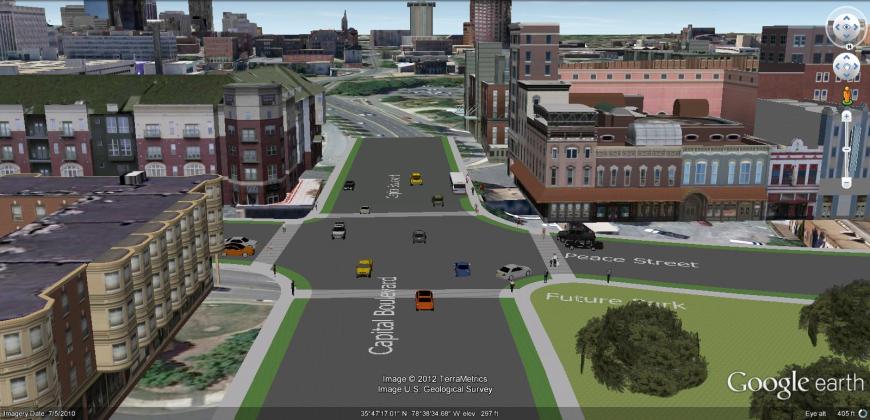A group of Raleigh residents are pushing city and state officials for a study that would determine the feasibility of an intersection at Peace Street and Capital Boulevard instead of a bridge.
The campaign is called Link Peace Street and its supporters believe that an intersection, rather than a bridge, would foster development and growth along a vital corridor into Downtown Raleigh. Advocates are calling on the city and the state to study the option to determine if it’s feasible.
The recently-completed Capital Boulevard Corridor Study has been in the works for three years and outlines a major uplift that would take place over the next decade. City and state planners say they considered an intersection to replace the aging bridge, but the traffic volume was too high to make the idea feasible.
Part of this $60 million renovation includes replacing the Peace Street bridge that runs over Capital Boulevard. Built in the 1950s, the bridge has been in the NC Department of Transportation’s fix-it list for some time. The NCDOT owns both the bridge and Capital Boulevard, so despite a close working relationship with the city, the state will ultimately make the call on what happens on both roadways.

A vision for a Peace Street intersection created by Link Peace Street.
Creating a Walkable Area
Jim Belt of the Downtown Living Advocates said he didn’t even consider an intersection as an option until he began looking at the study and what city planners envisioned for the area. He said that in the end, he decided that an intersection made more sense.
“It seemed like such the right answer,” he said.
Supporters say that a street-level intersection would allow for the development of mixed-use retail and residential projects that are in easy walking distance near a proposed light rail stop.
In terms of revitalization, “There has been nothing going on in that particular corridor,” Belt said. “That area is not connected well.”
Belt said that because of the street and bridge configuration, nothing in that area is easily or safely accessible by walking. Going anywhere requires getting into a car, and if a resident is already getting in his car, there are a number of different places in Raleigh to go.
Cotton Mill resident Chris Roberts said his neighbors already have a difficult time getting in and out of their parking lot from Capital Boulevard and the proposed bridge configuration would make it even more of a hassle.
Echoing Belt’s comments, Roberts said that it’s impossible to walk safely from his building to downtown Raleigh.
Because of the highway and the subsequent bridge, Roberts said that development opportunities are lost on what would be a great location. An architect by trade, Roberts added that he thinks the bridge is counter-intuitive to the 2030 Comprehensive Plan, which strives to link Raleigh together with a pedestrian friendly and transit-oriented environment.
He added that the area will never be the central business district that it could be unless the connectivity is improved.
Belt said that the goal of the Link Peace Street campaign is just to get the city to study the option.
“We’re not traffic engineers, nor do we pretend to have a solution for the traffic beyond what the people in the city have,” he said.
City: Too Many Cars
City transportation manager Eric Lamb said planning staff considered an intersection and took a look at the traffic patterns for the area.
“What we saw had a lot of adverse characteristics,” he said.
Lamb said that 55,000 cars per day pass through the section of Capital Boulevard between Wade and Peace streets. About 20,000 cars come across Peace Street.
“When we started looking at how many lanes you would need to make it work, it was pretty ugly,” he said.
He said the intersection would be similar to that of Capital Boulevard and Buffaloe Road.
“To say that the devil is in the details is an understatement” said Lamb.
Since the corridor was built with a bridge and not with an intersection, it would take a significant amount of excavation to level the area.
“You’re also going to end up with a surprising amount of retaining wall when you look at the surrounding area,” he said.
Joey Hopkins, an NCDOT engineer assigned to the project, said that because of the traffic volume, an intersection was never a serious option.
“It was kind of considered,” he said. “But it wasn’t anything that was taken any further than that.”
On top of the congestion, Hopkins said that the railroad tracks on either side of Capital Boulevard pose a problem. Because of those tracks there isn’t a good grid system that could divert traffic caused by the additional intersection.
“A lot of folks are going to choose not to go through that congestion,” Hopkins said. “They’re going to choose other ways. You’re moving that burden somewhere else.”
In a perfect world, the city would be able to mitigate those problems by fixing the grid system, but those plans are hindered by the tracks.
While the original Capital Boulevard study was done in house with pro-bono contributions from private firms, Lamb said that a study on an intersection like Peace Street could cost anywhere between $15,000 and $50,000 depending on how many scenarios were considered. He added that this study would also be done by the city.
“We share exactly the same goals as the Link Peace Street folks,” Lamb said. “I think that same scale of development will be realized with the square route configuration that we have on the table.”
Link Peace Street campaigners hope to cause enough of a stir that the option will be discussed at the May 1 council meeting.
“We’re very open to have [the city] come and talk with us any time,” Belt said. “We’re just trying figure out a way to make this area grow.”
